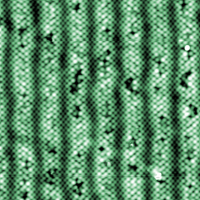High-Tc superconductivity
The mechanism driving superconductivity at high temperature keeps challenging the scientific community. We are investigating high temperature superconducting (HTS) copper oxides, where the normal state and the superconducting phase are equally intriguing and challenging our understanding. Materials of interest are YBa2Cu3O7-d (Y-123) and Bi2Sr2CaCu2O8+d (Bi2212) at various hole concentrations.
Scanning tunneling microscopy and spectroscopy are techniques of choice to characterize these materials. Imaging can resolve charge ordered phases in real space, and spectroscopy gives access to key features in the local density of states with high spatial resolution.

Recently, we solved a long standing open question concerning the electronic structure of the vortex cores in Y-123. Combining high resolution STS and an original theoretical approach, we found that the vortices in Y-123 exhibit a core signature compatible with the predictions for a d-wave BCS superconductor. This study further shows that in a disordered lattice, every vortex core signature is slightly different due to the changing local environment. The STM data and model claculations finally show that the core shape is not driven by the gap symmetry, but by the Fermi surface topology.
Current key questions are the nature of the normal state, and the interplay between superconductivity and charge order observed in both cuprates we are investigating. We are also investigating whether the model used to analyse the vortex cores in Y-123 can be applied to Bi-2212.